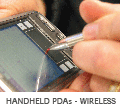Zigbee
Zigbee Introduction
Zigbee is a technology used for communication between small low devices devices such as wireless sensors. It is similar to Bluetooth in concept but aims to offer lower cost and better handling of large networks of closely spaced devices. Zigbee is touted as the next big thing in home automotation and building control. It also has relevant to large sensor networks as might be found in vineyards and farms.
The Zigbee standards sit on top off IEEE standard 802.15.4 which defines a radio and a MAC (medium access layer) which supports addressing and framing but not reliable transport. The core standard defines message passing mechanisms and allows other application-specific profiles to fit on top. At the moment (2007) the Zigbee Home Automation Profile is reasonably well defined, with others in progress.
The Zigbee Home Automation profile defines objects such as lights, switches, temperature sensors and thermostats and the messages which can be passed between them. Objects can normally be divided into wireless sensors, which sense information from the environment, and wireless controls, which control some aspect of the environment. Using this approach it is possible to connect up these devices within a house and have them communicate to perform various automated tasks. The wireless nature of Zigbee makes installation easier, although devices not connected to the mains need some sort of power source.
Zigbee generally uses the 2.4GHz band which provides around 250 kbits/s bandwidth (reduced by contention, protocol overheads, etc.) with a range of 10-75m using a 1mW radio.
Variants
The Zigbee protocol stack is fairly substantial, permitting the formation of meshed networks with thousands of devices. The Zigbee Standard defines three types of devices with increase complexity:
- Zigbee Coordinator - this can guide the formation of a network and communicate with other networks
- Zigbee Router - this can receive packets destined for other devices and pass them on
- Zigbee End Device - this con only receive its own packets and communicate with its assigned parent. This permits simpler software and also lower power operation since the device may only be powered periodically. This is often used for wireless sensors.
Zigbee transceiver chips are available for US$1 or so in high volumes (2007). These require some sort of microcontroller to operate the 60-100KB of protocol code in the Zigbee stack and the chosen profile.
Some of the transceivers available include:
- Atmel AT86RF230 [http://www.atmel.com/dyn/products/product_card.asp?part_id=394 transceiver chip1
- TI (was Chipcon) CC2420 transceiver chip
More information
A good introduction is available at Christopher Diamond's site. You can also look up The Zigbee Alliance
End User Devices
Zigbee is becoming available in devices such as thermostats and controllers, but it is early days as yet (2007).
Bluewater Systems Experience
Bluewater has investigated Zigbee for several clients and has built up knowledge on two different tranceiver chips, the protocol stack in general and the home automation profile. Bluewater uses an experienced partner for work requiring detailed Zigbee knowledge.
Zigbee on Rig 200
The Rig 200 Location Plus Module provides a Zigbee Module which is available through a simple serial interface and a C API to applications running on Rig 200. This can operate as a coordinator in a Zigbee network and communicate with other devices such as wireless sensors.




